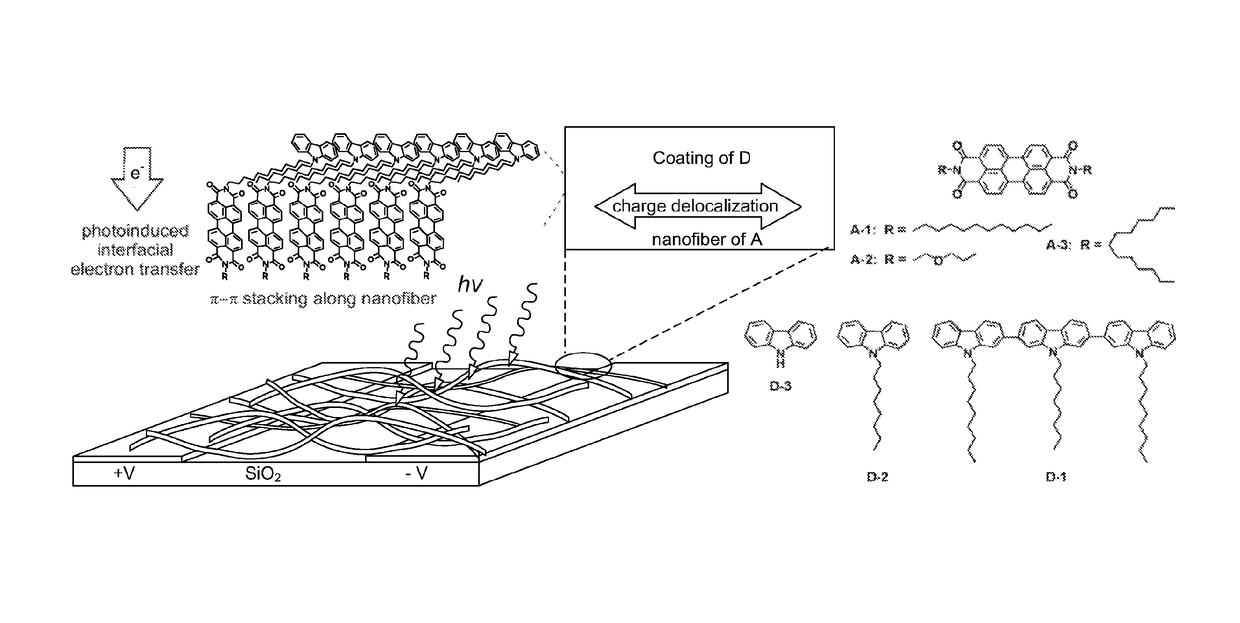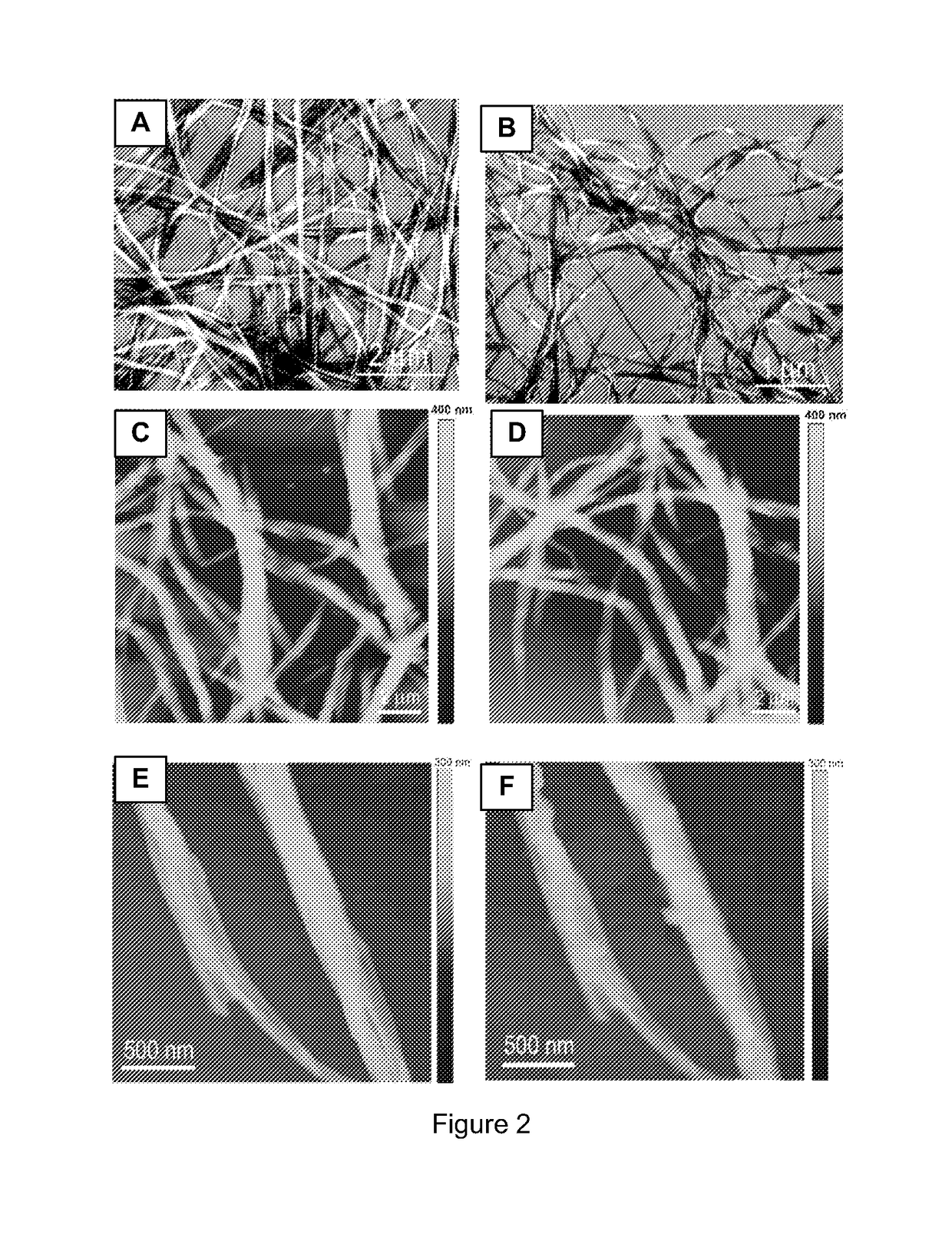Nanofiber-based heterojunction approach for high photoconductivity on organic materials
a heterojunction and organic material technology, applied in the field of photoconductive organic semiconductor materials, can solve the problems of loss of photogenerated charge carriers through recombination, limited availability of organic materials, impractical in large-scale applications, etc., and achieve the effect of high photoconductivity and fast photorespons
- Summary
- Abstract
- Description
- Claims
- Application Information
AI Technical Summary
Benefits of technology
Problems solved by technology
Method used
Image
Examples
example 1
Synthesis of A-1, A-2, and A-3
[0051]Molecules A-1, A-2, A-3 were synthesized following the previously developed methods as described in Acc. Chem. Res. 41, 2008, 1596-1608, which is incorporated here by reference.
example 2
Synthesis of D-1 and D-2
[0052]D-1 and D-2 were synthesized as follows:
[0053]
[0054]2,7-dibromo-9-octyl-9H-carbazole 2 (220 mg, 0.5 mmol), 9H-carbazole-2-boronic acid pinacol ester 1 (880 mg, 1.5 mmol) and benzyltriethylammonium chloride (50 mg) were added into a mixture of toluene (20 mL) and aqueous K2CO3 (2M, 8 mL), followed by three freeze-pump-thaw cycles of degassing. Pd(PPh3)4 (5 mg) was then added under argon protection, again followed by three freeze-pump-thaw cycles of degassing. The mixture was refluxed for 24 h and the organic phase was separated and evaporated. The product was purified by column chromatography on silica gel (hexane / THF, 4:2) and dried in vacuum. A 220 mg (71%) yield of compound 3 was obtained as a light brown powder. 1H NMR (THF-d8, 500 MHz): δ=10.33 (s, 2H), 8.15 (m, 4H), 8.07 (d, J=7.9, 2H), 7.82 (m, 4H), 7.6 (m, 4H), 7.43 (d, J=8.0, 2H), 7.34 (m, 2H), 7.15 (m, 2H), 4.56 (t, J=7.19, 2H), 1.99 (m, 2H), 1.29 (m, 10H), 0.83 (t, J=6.9, 3H). MALDI-TOF MS: m / ...
example 3
Fabrication of a Nanofibers and the Nanofibril Heterojunctions with D Molecules
[0058]A-1, A-2, and A-3 molecules were obtained according to Example 1. The A-1 nanofibers were fabricated by injecting 0.5 mL chloroform solution of A-1 molecules (0.15 mM) into 3 mL ethanol in a test tube followed by 5 hours of aging. The nanofibers formed can be transferred and cast onto glass surface by pipetting. The nanofibril heterojunctions were fabricated by directly drop-casting the ethanol solution of the D molecules onto the nanofibers pre-deposited on the silica substrate. D-1 and D-2 were obtained as disclosed in Example 2; D-3 was directly obtained from Sigma-Aldrich. The concentrations of ethanol solution as employed for D-1, D-2, and D-3 were 0.1, 1, and 1 mM, respectively.
[0059]The A-2 nanofibers were fabricated in the same way.
[0060]The A-3 film was fabricated by drop-casting a chloroform solution of A-3 (20 nM) on the substrate.
[0061]Property Characterization of Nanofibers:
[0062]Fluore...
PUM
| Property | Measurement | Unit |
|---|---|---|
| length | aaaaa | aaaaa |
| length | aaaaa | aaaaa |
| photocurrent generation quantum efficiency | aaaaa | aaaaa |
Abstract
Description
Claims
Application Information
 Login to View More
Login to View More - R&D
- Intellectual Property
- Life Sciences
- Materials
- Tech Scout
- Unparalleled Data Quality
- Higher Quality Content
- 60% Fewer Hallucinations
Browse by: Latest US Patents, China's latest patents, Technical Efficacy Thesaurus, Application Domain, Technology Topic, Popular Technical Reports.
© 2025 PatSnap. All rights reserved.Legal|Privacy policy|Modern Slavery Act Transparency Statement|Sitemap|About US| Contact US: help@patsnap.com



